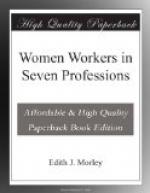The Health Visitor is usually paid a lower salary than the Woman Sanitary Inspector; this ranges in London from L100 to L120; in the provinces it may be as low as L65 per annum, and rarely rises above L100. The hours of work and holidays are, as a rule, the same as for Women Sanitary Inspectors. The difference in salary has proved a great temptation to Local Authorities in London to appoint Health Visitors when Women Sanitary Inspectors would have been more useful and efficient officers. Indeed, it is to be deplored that very few members of Local Authorities understood the advantages to be gained by the appointment of the more highly qualified official. The immediate effect of Section 7 was that several boroughs, having no women officials, proceeded to appoint Health Visitors; other boroughs, which possessed Women Sanitary Inspectors, also appointed Health Visitors. Seven or eight boroughs re-appointed their women officials in the dual capacity of Sanitary Inspector and Health Visitor so that the work in those cases went on as before. An indirect effect has been the almost complete cessation of the appointment of Women Sanitary Inspectors and the diminution in their number in some boroughs by the lapse of appointments on resignation or marriage. The inspection of workshops where women are employed has, in several instances, fallen back into the hands of Men Inspectors, whose unsuitability for this work first called women in England into the Public Health Service.
In September 1909 the Local Government Board issued the following order with regard to Health Visitors in London:—
“Art. 1. Qualifications. A woman shall be qualified to be appointed a Health Visitor if she
(a) is a duly qualified medical practitioner ; or
(b) is a duly qualified nurse with three years’ training in a hospital or infirmary, being a training school for nurses and having a resident physician or surgeon; or
(c) is certified under the Midwives’ Act, 1902; or
(d) has had six months’ nursing experience in a hospital receiving children as well as adults, and holds the certificate of the Royal Sanitary Institute for Health Visitors and School Nurses, or the Diploma of the National Health Society; or
(e) has discharged duties similar to those presented in the regulations in the services of a Sanitary Authority and produces such evidence as suffices to prove her competency; or
(f) has a competent knowledge and experience of the theory and practice of nurture, and the care and management of young children, of attendance on women in and immediately after child-birth, and of nursing attendance in cases of sickness or other mental or bodily infirmity.
“Art. 2. Every appointment must be confirmed by the Board.
“Art. 6. Enables a Sanitary Authority to determine the appointment of a Health Visitor by giving her three months’ notice, and no woman may be appointed unless she agrees to give three months’ notice previous to resigning the office or to forfeit a sum to be agreed.




